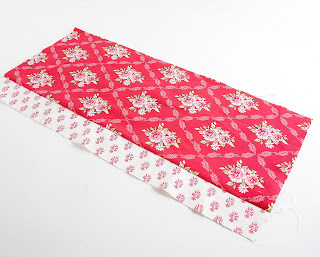I thought some of you may appreciate a bit of jargon busting!
Sewing, as with many crafts and hobbies, seems to have
its own vocabulary, so lets see if I can translate a few of the most common terms.
Grain:
This is the direction of the fabric, the north and south
if you like, as the fabric comes off the roll with the selvedge either side.
Cross grain:
If the grain is the north and south, this is the east and
west, so the cross grain is the direction from side to side.
Bias:
This is the 45 degree angle to the straight line. Bias
tape is strips of fabric cut at this angle, as bias cutting creates a bit of
stretch in the fabric, so when trimming anything with a curve, the bias tape
won’t pucker.
Selvedge:
The selvedge is the term for the edges of the fabric,
where the thread has been looped back to stop the fabric from unravelling. Some
manufacturers will print the brand name here, and a reference to the colours
used in the print. Always cut off the selvedge before you start a project as
the weave tends to be slightly different to the fabric, but take a good look at
it before you throw it away, some selvedges make lovely trims!
Warp:
The threads in your woven fabric that go up and down.
Weft:
The threads that go across your fabric. An easy way to
remember is that these threads go ‘weft to right’.
Pre-wash:
Washing and drying your fabric before you start to sew
will eliminate shrinkage in your finished project, so wash it in the same way as
you would wash your finished item. That said, I don’t wash bags or cushion
covers, I spot clean them if they get dirty, so wouldn’t pre wash in this case.
The feel of you fabric may be a little softer
after washing as the sizing is washed away, if you like the crispness,
use a little spray starch when you iron it. If you’re concerned about colours
running, uncommon unless your fabric is red or purple, then just cut a small
piece and soak it in warm soapy water for half an hour or so. Whilst still wet,
place on some white kitchen roll and you’ll soon see if the colour’s running!
Bolt:
Fabric sold on a flat cardboard tube, the material is
usually folded in half.
Fat quarter:
Take a meter or yard of fabric and cut it in half
lengthways, then in half again widthways, and you’ll have four pieces of fabric
that measure around 18” x 22”. These are fat quarters. If you cut one of these
pieces in half lengthways, you have a fat eighth.
Fat quarters are commonly sold in packs of co-ordinating
colours and prints, such a good idea as you know they’re all going to match!
Jelly roll:
A roll of 2 ½” wide individual strips of co-ordinating
fabric, usually used in patchwork and quilting. The pre-cut strips can be cut
into squares, diamonds and triangles, or used for sashing [the strips that separate
quilt blocks].


















































